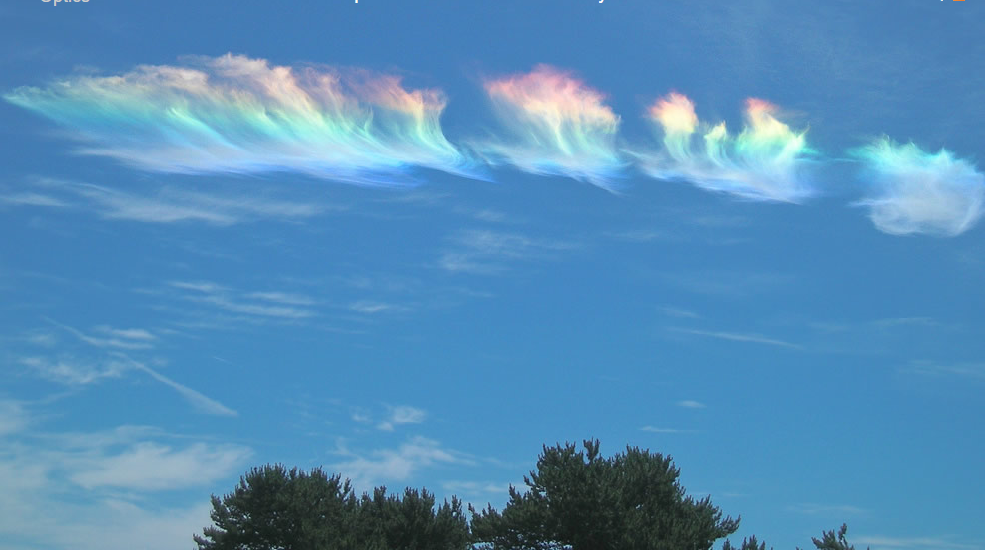CHA
Exploring the Phenomenon of Circumhorizon Arcs
Circumhorizon arcs (CHAs) are a fascinating atmospheric optical phenomenon that captivates the beholder with its breathtaking display of colors. Unlike traditional halos that form around the sun or moon, CHAs manifest as a band of vibrant hues parallel to the horizon. These arcs are formed by the glints of spectral sunlight reflecting off countless tiny plate-shaped ice crystals within high cirrus clouds. When the cirrus layer is continuous, the crystals collectively create a brilliant display of colors, while discontinuous clouds showcase individual bursts of vivid hues.
CHAs are a relatively rare sight to behold, requiring specific atmospheric conditions for their formation. The optimal conditions include the presence of high cirrus clouds, typically composed of ice crystals, and the sun's elevation angle exceeding 58 degrees. Additionally, the observer must be located between 46 degrees and 58 degrees latitude to witness this awe-inspiring spectacle.
The Science Behind Circumhorizon Arcs
To understand the science behind CHAs, we delve into the intricate interplay between light and ice crystals. When sunlight passes through these microscopic crystals, it undergoes refraction and dispersion. This refraction causes the sunlight to split into its constituent colors, much like a prism, resulting in the formation of a spectrum. The dispersion effect is more pronounced when the sun is at a higher elevation angle, which explains why CHAs are often observed during the summer months.
The specific shape of the ice crystals is crucial in determining the characteristics of CHAs. Plate-shaped crystals are responsible for creating these arcs due to their unique orientation in the atmosphere. When sunlight enters these crystals, it undergoes two internal reflections before exiting at a specific angle. This angle, known as the minimum deviation angle, determines the position of the CHA in relation to the sun and observer.
An Enchanting Display of Colors
The vibrant colors exhibited by CHAs are a result of the dispersion of sunlight into its component wavelengths. As the sunlight passes through the ice crystals, the shorter wavelengths, such as blue and violet, are bent more than the longer wavelengths, like red and orange. This bending causes the colors to spread out and create a stunning spectrum along the arc.
As the observer's viewpoint changes, so does the appearance of the CHA. When viewed from a low altitude, such as from an airplane, the arc appears as a continuous band of vivid colors parallel to the horizon. However, when observed from the ground, the CHA can appear fragmented and broken due to the viewer's perspective.
Geographic Considerations
The formation of CHAs is influenced by geographical factors such as latitude and cloud coverage. Observers situated between 46 degrees and 58 degrees latitude have a higher chance of witnessing CHAs, as these arcs occur at specific solar elevation angles within this range. Furthermore, the presence of high cirrus clouds is essential for CHAs to form. These clouds consist of ice crystals that provide the necessary medium for sunlight to refract and create the mesmerizing display.
Capturing the Magic of CHAs
Photographing CHAs can be a challenging task due to their elusive nature and dependence on specific atmospheric conditions. However, with careful planning and a bit of luck, it is possible to capture these enchanting phenomena on camera. The following tips can help increase your chances of photographing a CHA:
- Choose a location with unobstructed views of the horizon and minimal light pollution.
- Monitor weather forecasts for the presence of high cirrus clouds.
- Time your photography session when the sun is at a sufficiently high elevation angle (above 58 degrees).
- Experiment with different camera settings, such as exposure and white balance, to capture the vibrant colors accurately.
- Consider using a polarizing filter to enhance the contrast and saturation of the CHA.
Appreciating Nature's Spectacular Display
Witnessing a circumhorizon arc is a rare and awe-inspiring experience that allows us to marvel at the wonders of our atmosphere. These vibrant bands of color serve as a reminder of the intricate processes occurring above us, where light and ice crystals converge to create breathtaking optical phenomena. By understanding the science behind CHAs and knowing when and where to look, we can increase our chances of witnessing this captivating display of nature's beauty. So, keep your eyes on the sky, and you may be fortunate enough to encounter a circumhorizon arc, an ephemeral masterpiece suspended in the heavens.

Circumhorizon Arc imaged by Caroline Tucker at Port Townsend, Washington July '08. Image ©Caroline Tucker, shown with permission.
This circumhorizon arc is remarkable in the way that it completely lights each fibrous tuft of high cirrus cloud. The halo is the collective glints of spectral sunlight from millions of small plate shaped ice crystals. When the cirrus layer is continuous the crystals glint along a huge band parallel to the horizon. Discontinuous clouds of ice crystals appear instead to be individually filled with colour.
Note: this article has been automatically converted from the old site and may not appear as intended. You can find the original article here.
Reference Atmospheric Optics
If you use any of the definitions, information, or data presented on Atmospheric Optics, please copy the link or reference below to properly credit us as the reference source. Thank you!
-
<a href="https://atoptics.co.uk/blog/cha/">CHA</a>
-
"CHA". Atmospheric Optics. Accessed on November 26, 2024. https://atoptics.co.uk/blog/cha/.
-
"CHA". Atmospheric Optics, https://atoptics.co.uk/blog/cha/. Accessed 26 November, 2024
-
CHA. Atmospheric Optics. Retrieved from https://atoptics.co.uk/blog/cha/.